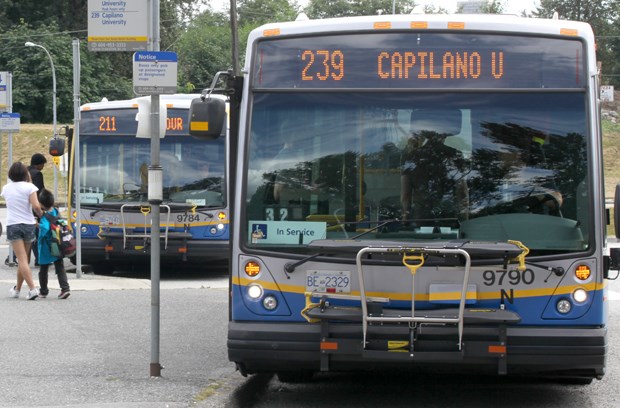The number of people taking transit to, from and around the North Shore climbed in 2016, although fewer people were choosing to hop aboard the SeaBus.
TransLink released its annual service performance review Wednesday showing annual boardings on the North Shore’s routes up by 800,000 over 2015, representing about four per cent growth. Boardings on the SeaBus declined by 2.8 per cent, however.
Total journeys across the TransLink system increased by 4.5 per cent last year to 233 million, according to the transit authority’s official data.
Most of the growth in North Shore ridership came from the main commuter buses that connect the denser neighbourhoods to downtown or transit hubs with connections to downtown.
“We’ve seen big jumps on the busy routes in the North Shore,” said Daniel Freeman, manager of transit network management. “The 250 and the 240 and the 239 are all doing really well and continuing to see ridership growth.”
Ridership on the 240, connecting downtown to Central Lonsdale, for example, was up by 7.4 per cent over the previous year. The 250, running between Horseshoe Bay and downtown, carried 5.8 per cent more passengers.
It’s the first full year of data since TransLink abandoned the multi-zone system for buses, making it much cheaper to take a bus downtown than the SeaBus. City of North Vancouver council worried this would lead people to abandon the SeaBus but the data doesn’t seem to be happening, Freeman said.
“If you’re in Lower Lonsdale, the SeaBus is really fast and attractive and it’s a really pleasant journey,” Freeman said. “If you’re in central Lonsdale, the 240 is a super-fast and frequent way to get downtown that you can’t beat. They’re different routes that serve different markets.”
The drop in SeaBus traffic is probably due to fewer than usual boardings last July, when traffic usually peaks due to tourism. Weather may be the culprit, Freeman suggested.
“The number of sunny days and rain by season, if you look at a one-route basis, sometimes can have a surprising effect that we don’t see in the total,” Freeman said.
Vehicle traffic over the Lions Gate Bridge stayed relatively steady in the same time period with 60,434 average annual daily crossings compared to 60,490 the year before, although traffic on the bridge has been creeping downward for over a decade (2.9 per cent), according to stats from the province. The Ironworkers Memorial Second Narrows Crossing, by contrast, has been growing in steadily in vehicle traffic, two per cent in 2016 or about 7.8 per cent since 2008.
TransLink uses the data from the performance review to tweak service hours and reallocate resources. The busiest routes that experience the most overcrowding will be getting more frequent service, ahead of the transit expansion coming from the TransLink mayors’ council.
Freeman described the service review as “a critical piece of information for us in our planning work to identify the next projects.”
The first phase of expansion includes a 14 per cent overall increase in bus service for routes that serve the North Shore including B-Line service linking Dundarave to Phibbs Exchange as well as a third SeaBus which is expected to be on the water and upping rush-hour service to every 10 minutes in 2019.



